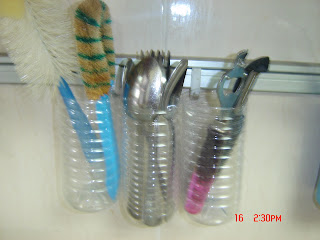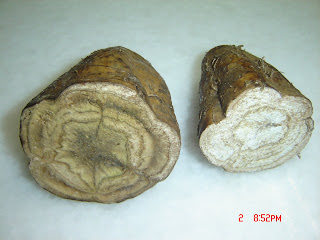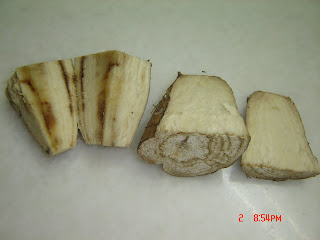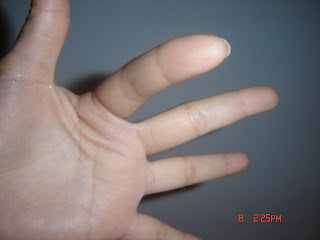I have put on some weight! I have been eating my children's leftovers because I don't like the idea of throwing away food that I have taken so much time to cook. They have not thought about the cost in getting the supplies and energy needed in the processes. They have forgotten about the children with no food to eat in war torn countries. They obviously do not value the love and efforts I put into cooking for them as much as I do.
I should put these thoughts and feelings to use by teaching my children how to grow their own vegetables and cook them. After all the efforts, I am sure they are less likely to throw away their own greens.
If you think that children are not capable of such tasks, then you have obviously not heard about "The Edible School Yard". It is a programme of an urban public school, Martin Luther King Junior Middle School, in Berkeley, California, where the students have more than an acre organic garden and a kitchen for classroom.
Hear what the founder, Alice Waters, and teachers in "The Edible School Yard" have to say about the effects this programme have on the children.
And, just in case this posting has inspired others to start a similar programme in their community, don't forget to check out their "How To" link. You can also try googling "edible classroom garden" to see if there are any such programme in your own country.
You may also want to read about "Forest Gardening" or download Dave Sansone's booklet on "Edible Forest Gardens".
Here are some videos of "Forest Gardening with Robert Hart".
I have covered composting in my earlier posting.
The art of recycling for a greener environment starts with seeing trash as "abandoned material" so that we can create "Abundance from the Abandoned" in "Amazing Ways".
Monday 31 March 2008
Saturday 29 March 2008
Compost pile: what's in, what's out?
I used to think that you can compost all kinds of food waste, including used cooking oil until I discovered Compost This.
It reported that cooking oil attracts rodents or other undesirable creatures to your compost heap. It can also displace water which will slow down the composting process.
Leftover food you are not supposed to add to your compost pile are:
Baked Beans
Meat
Fish
Fat
Pasta
Bread
Biscuits
Cake
You can read their reasons for not using these leftovers. Now that we know that, what can we do with the used cooking oil?
You can find the answer by doing a search on "cooking oil" at "How Can I Recycle This?"
So, before you throw away any leftovers, remember that there are many people out there who are very eager to share their tips and tricks for reducing waste.
It reported that cooking oil attracts rodents or other undesirable creatures to your compost heap. It can also displace water which will slow down the composting process.
Leftover food you are not supposed to add to your compost pile are:
Baked Beans
Meat
Fish
Fat
Pasta
Bread
Biscuits
Cake
You can read their reasons for not using these leftovers. Now that we know that, what can we do with the used cooking oil?
You can find the answer by doing a search on "cooking oil" at "How Can I Recycle This?"
So, before you throw away any leftovers, remember that there are many people out there who are very eager to share their tips and tricks for reducing waste.
Friday 28 March 2008
Leftover juice? Great ingredient for vinegar.
I have discovered from Vinegar Man that you can make vinegar out of juice from fruits or grains or roots and even wood as long as it contains sugar or starch.
So, before you throw away any leftover juices, take a look at "Vinegar Types, Methods of Making Vinegars Recipes" on Harvestfields, to see how you can make use of them.
And if you are worried that you will be wasting your time if your homemade vinegar did not turn out well enough for consumption, just spray it in your garden to help get rid of those weeds!
Don't forget to keep the leftover wine (fermented juice) as well. Gang of Pour tells you how in their article "So, Ya Wanna Make Vinegar From Leftover Wine, Eh?". Don't miss their do's and don'ts on the fine art of making vinegar.
So, before you throw away any leftover juices, take a look at "Vinegar Types, Methods of Making Vinegars Recipes" on Harvestfields, to see how you can make use of them.
And if you are worried that you will be wasting your time if your homemade vinegar did not turn out well enough for consumption, just spray it in your garden to help get rid of those weeds!
Don't forget to keep the leftover wine (fermented juice) as well. Gang of Pour tells you how in their article "So, Ya Wanna Make Vinegar From Leftover Wine, Eh?". Don't miss their do's and don'ts on the fine art of making vinegar.
Leftover mushroom? Grow them!
I buy oyster mushroom almost every week and I have been told by my supplier that they will remain fresh 2 to 3 days refrigerated. So, what if your package has more mushroom than you need for your recipe?
If you have some glass jars on hand, you can try growing new mushroom out of your leftovers if you place them in the right environment and medium for the spores to grow.
Wikipedia has a good list of substrate or growth medium for you to choose from and most of them are waste material that you maybe able to acquire free of charge. Here are some examples extracted from that list:
# Wood chips or sawdust
# Mulched hay
# Corncobs
# Waste or recycled paper
# coffee pulp or grounds
# Nut and seed hulls
# Cottonseed hulls
# Cocoa bean hulls
I have watched how mushroom was grown with strawbedded horse manure and urea on "Dirty Job with Mike Rowe". Here is a video clip from "How It's Made" posted on YouTube.
Other than Wikipedia, you can also read "How to Grow Mushrooms" posted by BioHaze on Squidoo.
Don't like reading? You can view videos posted on YouTube by MushroomVideos. Let's start with Part 1 of 4.
There are definitely lots of stuff that you can consider doing your 3Rs (Reduce, Reuse, Recycle) just by cultivating mushrooms.
Thursday 27 March 2008
Beading string? Found in sports club.
If you take a look at the strings used in stringing rackets for badminton, tennis or squash, you will notice that they look like you could possibly use them to create handmade jewellery.
No, I am not suggesting that you buy them for stringing beads. Just be friendly to the staff who works on stringing rackets at shops or sport clubs. They may keep some leftover strings that are long enough for you to work on creating this bracelet.
Use shorter length strings for making earrings.
No, I am not suggesting that you buy them for stringing beads. Just be friendly to the staff who works on stringing rackets at shops or sport clubs. They may keep some leftover strings that are long enough for you to work on creating this bracelet.
Use shorter length strings for making earrings.
Friday 14 March 2008
Kids not recycling? Let's play games.
If you find that your children have no interest to learn more about recycling or conserving resources =$, then it is time to let them play some online games. Here are some that I have discovered on the web:
At World Recycling Games the children have 6 kinds of games to play with. There is also a Teachers Resources link for you to find facts to questions that they may ask after playing the games .
Playing Dumptown Game is like playing Monopoly. There are program icons your children can pick that will give them information about what the program does and how much it costs to start using it and the maximum amount they can spend in the game. The Total Cost bar shows them how much they are spending.
If your children are creative, you can try getting them to create the pieces out of cardboards so that they can play it with their friends offline.
The Premier Xmas Recycling Game and Recycling Fun will teach the children what is recyclable and where each item should go.
At Bottlesandcans.com the children can click on their link to "Play the Recycling game!". If you are living in California, they can also learn about California Refund Value (CRV) and how much they can earn when they return used containers to a Recycling Center near your home.
So, Californians, the next time your children ask you for money to buy what they want, remember to lead them to the Cash Calculator and let them find out how many containers they need to recycle to get that amount. Then, get them to recycle!
At World Recycling Games the children have 6 kinds of games to play with. There is also a Teachers Resources link for you to find facts to questions that they may ask after playing the games .
Playing Dumptown Game is like playing Monopoly. There are program icons your children can pick that will give them information about what the program does and how much it costs to start using it and the maximum amount they can spend in the game. The Total Cost bar shows them how much they are spending.
If your children are creative, you can try getting them to create the pieces out of cardboards so that they can play it with their friends offline.
The Premier Xmas Recycling Game and Recycling Fun will teach the children what is recyclable and where each item should go.
At Bottlesandcans.com the children can click on their link to "Play the Recycling game!". If you are living in California, they can also learn about California Refund Value (CRV) and how much they can earn when they return used containers to a Recycling Center near your home.
So, Californians, the next time your children ask you for money to buy what they want, remember to lead them to the Cash Calculator and let them find out how many containers they need to recycle to get that amount. Then, get them to recycle!
Thursday 13 March 2008
Scratched CD/DVDs? Banana to the rescue.
Got yourself a bunch of bananas and couldn't finish it? Don't just let them rot on you. I discovered from Lifehacker that other than toothpaste, Pledge or Brasso, bananas are very handy in getting the scratches off your CDs and DVDs.
And just in case you are wondering if the banana really works, someone has tested it out.
So, before you dump your scraps into a food waste disposer or discard them, check out if I have posted any new uses for them under "Food".
And just in case you are wondering if the banana really works, someone has tested it out.
So, before you dump your scraps into a food waste disposer or discard them, check out if I have posted any new uses for them under "Food".
Labels:
Abundance From Abandoned,
Amazing Ways,
Food,
Free Tutorials,
video
Wednesday 12 March 2008
Ikea accessories? Improvised with waste.
I love this Ikea suspension rail installed in my kitchen.

The little hooks to go with it can only hold about 1 or 2 items together. Instead of hanging more hooks, I can buy additional accessories like the cutlery stand to hold more stuff together but I decided to save some cost by improvising and here are some of the ideas I came up with.


I created these by cutting up empty plastic bottles from drinks and detergent. I like the see through plastic which makes looking for the stuff I need a breeze. Since it was just before Chinese New Year, I am happy that I could decorate them with festive stickers to mark the occasion.

They are great for holding my scissors nice and safe.

My efforts saved me RM100! So, before you throw away your packaging, click on my link to Packaging to see if I have created something useful out of them.

The little hooks to go with it can only hold about 1 or 2 items together. Instead of hanging more hooks, I can buy additional accessories like the cutlery stand to hold more stuff together but I decided to save some cost by improvising and here are some of the ideas I came up with.


I created these by cutting up empty plastic bottles from drinks and detergent. I like the see through plastic which makes looking for the stuff I need a breeze. Since it was just before Chinese New Year, I am happy that I could decorate them with festive stickers to mark the occasion.

They are great for holding my scissors nice and safe.

My efforts saved me RM100! So, before you throw away your packaging, click on my link to Packaging to see if I have created something useful out of them.
Monday 10 March 2008
Reducing food wastage with waste
I received an interesting email from my friend. It was about someone sharing her discovery that aluminum coated bags can be used to keep fruits and vegetables fresh in the refrigerator.
These are bags used in the packaging of most milk powder, biscuits, cereals and peanuts. There was a picture showing her carrots, ocras (lady's fingers) and tomatoes looking fresh after one week in storage.
I kept a Chips More chocolate chips bag and bought a piece of Kudzu (Fun Got in Cantonese) to experiment with the idea.

I forgot about my experiment with the Kudzu and bought another piece the following weekend. This piece I kept as is in the refrigerator. When it was time for me to use my Kudzu, this is what I discovered.

The smaller piece on the right was the one I bought earlier and kept in the Chips More bag. Look at the difference when I cut them up.

So, it is obvious that you can keep your vegetable fresh for more than a week in aluminum coated bags. Now I have a clear plastic bag that I stick to the side of my fridge with a magnet to store all the aluminum coated bags.
It is great to be able to reduce food wastage with waste.
These are bags used in the packaging of most milk powder, biscuits, cereals and peanuts. There was a picture showing her carrots, ocras (lady's fingers) and tomatoes looking fresh after one week in storage.
I kept a Chips More chocolate chips bag and bought a piece of Kudzu (Fun Got in Cantonese) to experiment with the idea.

I forgot about my experiment with the Kudzu and bought another piece the following weekend. This piece I kept as is in the refrigerator. When it was time for me to use my Kudzu, this is what I discovered.

The smaller piece on the right was the one I bought earlier and kept in the Chips More bag. Look at the difference when I cut them up.

So, it is obvious that you can keep your vegetable fresh for more than a week in aluminum coated bags. Now I have a clear plastic bag that I stick to the side of my fridge with a magnet to store all the aluminum coated bags.
It is great to be able to reduce food wastage with waste.
Labels:
Abundance From Abandoned,
Amazing Ways,
Food,
Kitchen tips,
Packaging
Tuesday 4 March 2008
Make money from vomit and shit.
Caught Mike Rowe on Dirty Jobs and discovered that there is money to be made from collecting owl vomit and turkey shit.
Catch Mike on Discovery Channel. I am sure you will discover many amazing ways to make money from the kind of materials that he had to handle. If the money is good, I am sure that there is a nauseous level that will not be an issue with you.
Good luck, Amigo.
Catch Mike on Discovery Channel. I am sure you will discover many amazing ways to make money from the kind of materials that he had to handle. If the money is good, I am sure that there is a nauseous level that will not be an issue with you.
Good luck, Amigo.
Past, Present, Future
All plants are green (past) before they die (present) and decompose (future) into bits in the soil. Do you see a green message in this T-shirt design?

Replace trees felled for development. You do not want your children to say that trees are things that my mother have seen during her time in the distant future.
Replace trees felled for development. You do not want your children to say that trees are things that my mother have seen during her time in the distant future.
Monday 3 March 2008
Green teaching aids? Found in fingers.
Paper is the most often used material in a classroom environment. You see paper in books, posters and notes. So, how can we reduce its usage and save some trees?
Look at your fingers and try moving the little finger. You will realised that your palm and the rest of your fingers will move along with it.

Move your index finger and you will notice that you have more control over the rest of your fingers and only your middle finger will move along with it.

The little finger is just like a child compared to the rest of the fingers. The palm represents the environment she is in. In her ignorance, her actions will affect more people in her environment. I see a strong figure in the index finger. Someone who is mature and more conscious about the effects her actions can create.
I see the ability of each finger to bend forward to touch the thumb. The thumb looks like someone of authority; a good support system to lead one on the right path.

Where do you stand where taking care of our environment is concerned? Do you want to be a little finger forever? Be a thumb. Show others how to make use of their ever ready fingers as teaching aid about keeping our environment green.
And if you are able to hold your audience's interest and have some time to spare, you can also talk about morality, with the help of your middle finger.
Look at your fingers and try moving the little finger. You will realised that your palm and the rest of your fingers will move along with it.

Move your index finger and you will notice that you have more control over the rest of your fingers and only your middle finger will move along with it.

The little finger is just like a child compared to the rest of the fingers. The palm represents the environment she is in. In her ignorance, her actions will affect more people in her environment. I see a strong figure in the index finger. Someone who is mature and more conscious about the effects her actions can create.
I see the ability of each finger to bend forward to touch the thumb. The thumb looks like someone of authority; a good support system to lead one on the right path.

Where do you stand where taking care of our environment is concerned? Do you want to be a little finger forever? Be a thumb. Show others how to make use of their ever ready fingers as teaching aid about keeping our environment green.
And if you are able to hold your audience's interest and have some time to spare, you can also talk about morality, with the help of your middle finger.
Labels:
Free Tutorials,
Nancy Made,
Pictures,
Teaching aid,
Useful tips
Sunday 2 March 2008
It's food scrap. Not waste.
I have read from GreenYes forum that many homes in USA have food waste disposer systems installed under their sinks.
This disposal system increase water usage as food scraps thrown into these garbage grinders need water to move the waste along pipes to the sludge system. This is filtered and chemically sanitized tap water down the drain, one of its members highlighted. And if sewer blockages of food debris are high in your area, where do you think these could come from?
I think that if house owners are not able to dispose of their food scraps that easily, they would make more efforts to reduce food scraps. California Integrated Waste Management Board has a very good FAQ page on Food Scrap Management to work on this issue.
Check out some useful links I have collected about reducing leftovers and how you can donate your food scraps. Watch out for more ideas I will come up with on reducing food scrap using abandoned material, of course.
This disposal system increase water usage as food scraps thrown into these garbage grinders need water to move the waste along pipes to the sludge system. This is filtered and chemically sanitized tap water down the drain, one of its members highlighted. And if sewer blockages of food debris are high in your area, where do you think these could come from?
I think that if house owners are not able to dispose of their food scraps that easily, they would make more efforts to reduce food scraps. California Integrated Waste Management Board has a very good FAQ page on Food Scrap Management to work on this issue.
Check out some useful links I have collected about reducing leftovers and how you can donate your food scraps. Watch out for more ideas I will come up with on reducing food scrap using abandoned material, of course.
Labels:
Down here in USA,
Food,
Useful tips,
Useful websites
Subscribe to:
Posts (Atom)